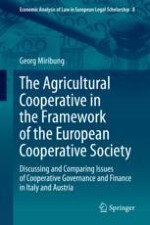2020 | OriginalPaper | Chapter
3. Defining Agricultural SCEs with Several Steps
Author : Georg Miribung
Published in: The Agricultural Cooperative in the Framework of the European Cooperative Society
Publisher: Springer International Publishing
Activate our intelligent search to find suitable subject content or patents.
Select sections of text to find matching patents with Artificial Intelligence. powered by
Select sections of text to find additional relevant content using AI-assisted search. powered by
